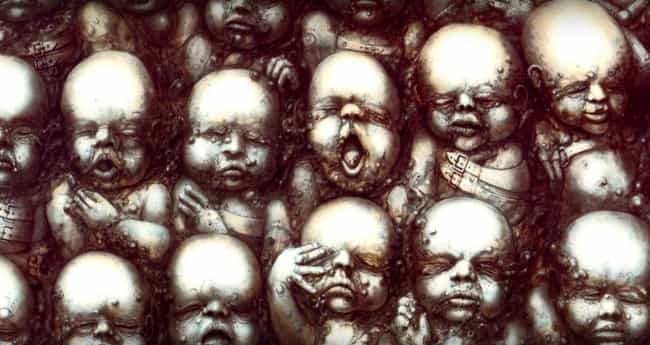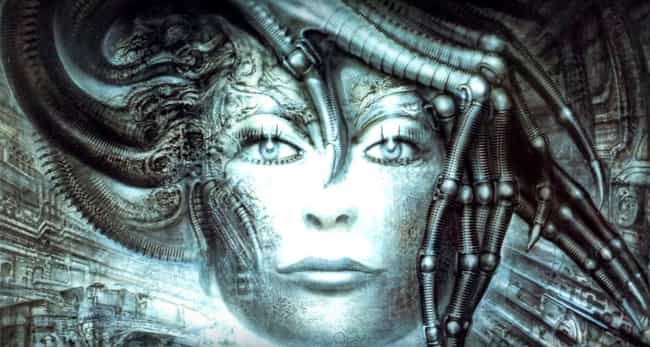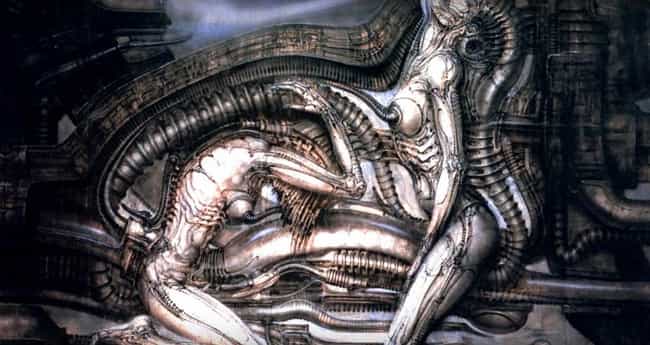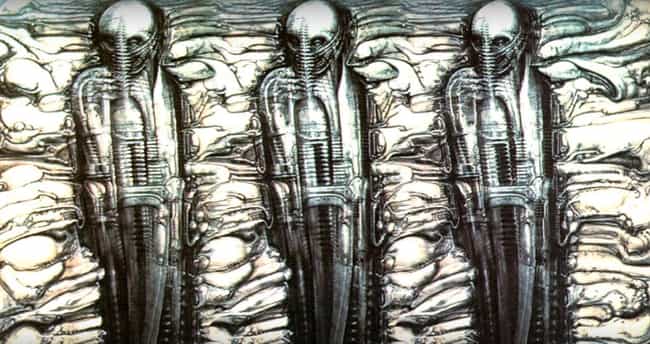As a child, Giger was beset with night terrors, a sleep disorder that causes episodes of intense fear, screaming, and flailing during rest. To combat this, he began drawing his nightmares in self-directed art therapy. Much of what viewers see in Giger’s work is something that once caused him fear, but instead became an inspiration.
Dan O’Bannon, the co-writer of Alien, once asked Giger why he was afraid of his visions since they were just a part of his mind. Giger responded, “That is what I am afraid of.”
Giger met actress Li Tobler in 1966, and they later became a couple, staying together for nine years. He often used her as a model in his art. Their relationship was said to include drug usage and promiscuity, which may have furthered psychological problems on both sides.
Tobler committed suicide in 1975. Giger was devastated, and his work took on a darker tone. He even kept a memento of her death. When a visiting friend noted there were some small holes in one of his canvases, Giger replied, "No, that's where my girlfriend blew her brains out."
As Freud would happily point out, much of Giger's work isn't just about death and biomechanics - it also includes a healthy dose of sex. Instead of painting traditional nudes, though, Giger dismembered bodies while keeping their pointy nipples and phallic protrusions intact.
Writing about Giger's artwork on display, the New York Times noted, "Galleries had to wipe the spit of disgusted neighbors from their windows." But the artist had plenty of fans; in the mid '80s, Giger's Landscape XX was included in the Dead Kennedys album Frankenchrist. The image resulted in an obscenity suit.
The Irish-born English painter Francis Bacon is known for his raw, often grotesque imagery. Giger noted the emotional energy and bold choices Bacon made in his work and admired the bleak existentialism his paintings depicted.
Giger wasn't the only one who was inspired by Bacon's twisted visions. Alien director Ridley Scott asked Giger to design the chestburster based on Bacon's Three Studies For Figures At The Base Of A Crucifixion. One of Alien's most memorable scenes is "pure Bacon," as Giger once
In Necronomicon, Giger described the basement of his childhood home as "a monstrous labyrinth where all kinds of dangers lay in wait for me" with "steep and treacherous wooden stairways without banisters [that] led down into the yawning abyss."
He later took an interest in industrial design and architecture and enrolled in art school to pursue these interests. Mechanical and structured designs also contributed greatly to the biomechanical fusion that made Giger famous.
Growing up in the 1940s in Europe, Giger remembered the terror caused by World War II. "I could feel the atmosphere when my parents were afraid. The lamps were always a bluish dark, so the planes would not bomb us. Switzerland and Germany are close. The targets weren't always very well marked. I felt the fear of that very much," he once noted in an interview.
In the mid-'60s, Giger became interested in the writings and theories of Sigmund Freud. As Freud suggested in his studies, Giger began to keep a dream journal. This allowed him to easily catalog his visions and return to them for future inspiration. Freud would probably have been very interested in Giger's overtly sexual, macabre work as well.
Living In Condemned Buildings Encouraged His Dark And Disturbing Visions
Giger lived in various places around Switzerland, many of which were abandoned and condemned. He lived with friends, and occasionally girlfriend Li Tobler, until the buildings were demolished and they were forced to relocate.
Setting up home in a decaying and forgotten building probably resonated with the dark workings of Giger's mind. He was also known for dressing all in black and keeping to the shadows, once commenting, "The places I liked most were the dark ones. As soon as I could dress myself, I wore black."
He Counted Salvador Dali And Timothy Leary Among His Friends
As a young artist, Giger was inspired by the dreamy, surrealist paintings of Salvador Dali. They were later introduced and became friends.
Giger was also befriended by psychedelic drug advocate Timothy Leary, who wrote introductions for several of Giger's art books in the 1980s. Leary commented, "Giger's work disturbs us, spooks us, because of its enormous evolutionary time span. It shows us, all too clearly, where we come from and where we are going."
He Adored H.P. Lovecraft
In 1926, science fiction author H.P. Lovecraft wrote, "Any magazine-cover hack can splash paint around wildly and call it a nightmare or a Witches’ Sabbath or a portrait of the devil, but only a great painter can make such a thing really scare or ring true. That’s because only a real artist knows the actual anatomy of the terrible or the physiology of fear - the exact sort of lines and proportions that connect up with latent instincts or hereditary memories of fright, and the proper colour contrasts and lighting effects to stir the dormant sense of strangeness."
Many years later, Lovecraft's ideas inspired a young Giger to continue his exploration of demons, fear, and the place of darkness in society. Giger also named his most famous collection of art, Necronomicon, after Lovecraft's fictional book of the same name.
He Did Not Enjoy The Film Industry
Giger became a household name thanks to his work on Alien, and even won an Oscar as part of the visual effects team. But the sequels to the film continued to use his designs however they liked without consulting him, and sometimes didn't even give him credit. He was later given work on films like Poltergeist II: The Other Side and Species, but never enjoyed the process quite as much."It's the realism that makes Giger's work so strong, not the fantasy," notes Ridley Scott.
In the 1990s, Giger bought a castle in Gruyeres, Switzerland. His reasoning behind the purchase? "I was always looking for something, a place for my paintings and sculptures, and I think a castle is the right place for me, no?" It opened as a museum in 1998 and houses the largest collection of his artworks.
Giger continued, "I get a lot of strange people who come to see my work in Gruyeres. It's very nice. You know people from the village they know my fans when they see them. They're all in black."
















No comments:
Post a Comment